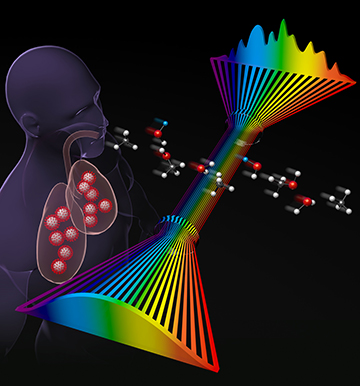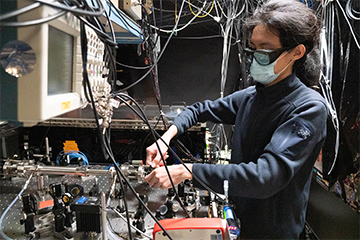
[Image: Steven Burrows/Ye and Nesbitt laboratories]
Inspired by the COVID-19 pandemic, physicists at a U.S. laboratory have upgraded a previously developed frequency-comb breath analyzer to detect the spectroscopic signatures of four biomarker molecules with a thousand times more sensitivity than previous tests (Proc. Natl. Acad. Sci. USA, doi:10.1073/pnas.2105063118).
The revamped breathalyzer relies on a mid-infrared (mid-IR) laser frequency comb, tunable from 3 to 5 μm, and a high-finesse optical cavity in the same wavelength range to boost its ability to detect simple molecules at the parts-per-trillion level. The tool’s creators are deploying it in a study to see if it can screen for the presence of SARS-CoV-2, the virus that causes COVID-19.
Building on previous work
In 2008, the research team—including scientists at JILA, part of the University of Colorado, USA, and the U.S. National Institute of Standards and Technology (NIST)—created a breathalyzer based on a frequency comb in a slightly different part of the spectrum, the near-IR. The instrument measured vibrational transitions in the 1.5- to 1.7-μm wavelength range. Not only was the near-IR device less sensitive than desired, but also, at the time, the researchers found a lack of large-scale clinical studies that could provide reliable links between breath biomarkers and specific diseases.
According to Optica Fellow Jun Ye, in whose JILA laboratory the instrument was built, the advent of the global pandemic in early 2020 inspired the researchers to build a more sensitive breath analyzer and use it to gather the needed clinical data. “COVID gave us this inspiration of wanting to make a difference for real this time,” he says.

University of Colorado grad student and study lead author Qizhong Liang adjusts JILA’s frequency-comb breathalyzer, which identifies molecules associated with disease based on colors and amounts of light absorbed inside the tube (left) containing breath samples. [Image: R. Jacobson, U.S. National Institute of Standards and Technology]
The experimental device is simple and straightforward. A researcher collects either a human breath sample or a reference gas in a polyvinyl fluoride bag, then pumps the bag’s contents into a high-finesse optical cavity, containing a pair of high-reflectivity mirrors. Light from a tunable mid-IR frequency comb passes through the cavity, where it interacts with the gas molecules over several thousand round trips. A Fourier-transform IR spectrometer analyzes the outgoing beam for the spectral signatures of molecules that could signal conditions ranging from hangover and halitosis to lung cancer.
Toward COVID testing and beyond
When the JILA team submitted its manuscript on the mid-IR comb breathalyzer to a journal in March 2021, the researchers had not yet received approval from a University of Colorado institutional review board for a medical study on human subjects. That nod came in May, by which time the university campus’s COVID-19 peak had passed. “So it’s been challenging to collect COVID-positive breath samples on campus,” Ye says. “Our immediate goal is to collect enough samples to enable statistically significant analysis.”
So far, the JILA researchers have collected more than 70 breath samples from Colorado students and faculty members on campus, and they are incorporating machine-learning tools into their data analysis to sort out tens of thousands of molecular absorption features.
“A student in our lab, Qizhong Liang, has become a self-taught machine-learning expert,” says Ye, who adds that Liang is “starting to uncover correlations” between breath data and certain group characteristics. David Nesbitt, a JILA scientist who works at the intersection of chemistry, biology and physics, is collaborating on this ongoing research.
“We are very motivated and committed this time, and will push this technology as far as we can [until] we make a real connection to medical science,” Ye says.
To become a successful clinical instrument someday, the comb breathalyzer will need to become smaller and easy for physicians to use. Ye says his team members are working with colleagues such as Scott Diddams of NIST and Greg Reiker of Colorado’s engineering school to make the technology robust and transportable.
